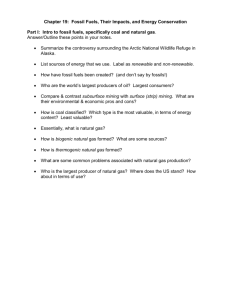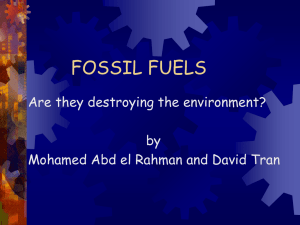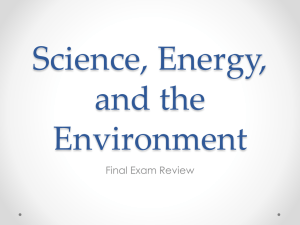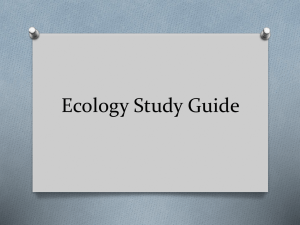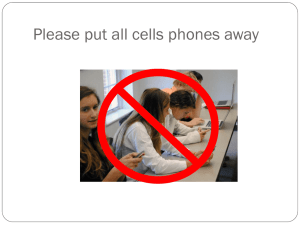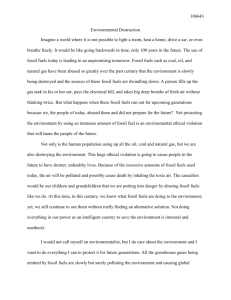Name Period ______ Date
advertisement
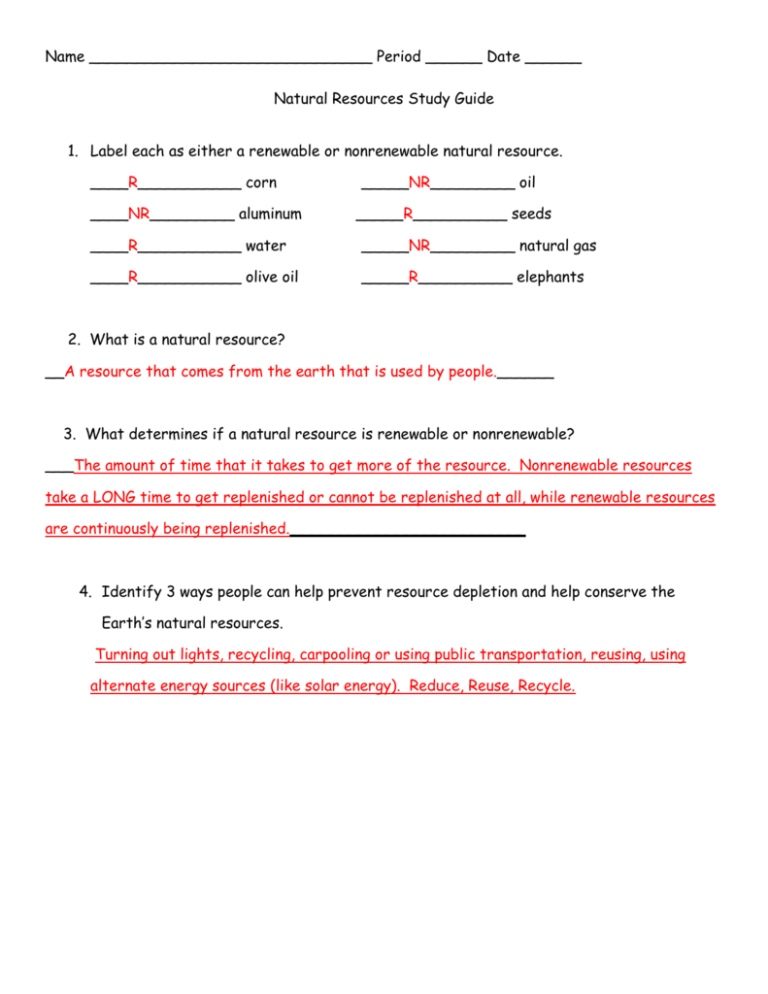
Name ______________________________ Period ______ Date ______ Natural Resources Study Guide 1. Label each as either a renewable or nonrenewable natural resource. ____R___________ corn ____NR_________ aluminum _____NR_________ oil _____R__________ seeds ____R___________ water _____NR_________ natural gas ____R___________ olive oil _____R__________ elephants 2. What is a natural resource? __A resource that comes from the earth that is used by people.______ 3. What determines if a natural resource is renewable or nonrenewable? ___The amount of time that it takes to get more of the resource. Nonrenewable resources take a LONG time to get replenished or cannot be replenished at all, while renewable resources are continuously being replenished._________________________ 4. Identify 3 ways people can help prevent resource depletion and help conserve the Earth’s natural resources. Turning out lights, recycling, carpooling or using public transportation, reusing, using alternate energy sources (like solar energy). Reduce, Reuse, Recycle. 5. Which type of energy is better? Provide reasons that support both possible answers. For example, list both nuclear energy’s advantages over fossil fuels AND fossil fuels’ advantages over nuclear energy. Nuclear Energy vs. Fossil Fuel Nuclear energy is better than fossil fuels because it causes less air pollution and does not give off carbon dioxide. Fossil fuels are better because they are good for the economy and have many uses. In addition, they do not produce radioactive waste, like nuclear energy does Solar Energy vs. Wind Energy Solar energy is better than wind because while both are clean and free (after the initial set up of solar panels/ windmills) all areas receive sun, where only certain areas get high amounts of wind. Wind energy requires large amounts of land. Wind energy is better because wind occurs during the day and at night, while solar energy only works well on sunny days (and not as well in the winter when there are less hours of sun.) Geothermal Energy vs. Biomass Geothermal energy is better than biomass because hot rocks can be found anywhere, and it is cleaner and doesn’t produce toxic ash/ air pollution like biomass does. Biomass is better because it is cheaper (setting up geothermal energy is very expensive) and leaves less garbage in landfills. 6. Describe acid precipitation. What pollutant causes it? Acid precipitation occurs when water particles condense on dust particles of pollution caused by burning fossil fuels. When rain falls it is acidic and damaging (even causing sink holes). 7. Why is ozone depletion a serious concern for us today? What causes it? Ozone protects us from the cancer causing ultraviolet rays given off by the sun. Ozone depletion is caused by CFCs released into the air. 8. What famous attraction can I visit in the United States to witness geothermal energy in action? Old Faithful, a hot water geyser 9. What are the causes of water and soil pollution? WATER POLLUTION: Pesticides and fertilizers from farms, oil spills, factories, and people dumping hazardous wastes into water ways. SOIL POLLUTION: Pollutants from the air and water, littering, and landfills. 10. Circle the resources that produce the least amounts of pollution: Solar energy Nuclear Energy Hydroelectric Petroleum Geothermal Energy Biomass Natural Gas Wind Energy Coal 11. What causes smog to be produced? Smog is caused by sunlight reacting with pollutants in the air from burning fossil fuels. Areas that are surrounded by natural barriers, like mountains are more likely to experience smog problems. 12. What is the difference between fission and fusion? Identify the energy resource these process use to create energy. Fission is splitting the atom and fusion is joining the nuclei of two atoms. Fission uses uranium as an energy source. We cannot currently use fusion as an energy source 13. What is the relationship between global warming and the greenhouse effect? The greenhouse effect causes global warming because carbon dioxide in the atmosphere (given off by the burning of fossil fuels) traps heat close to the earth and does not allow it to escape. 14. Why is global warming a concern? If the temperature of the planet increases, it could lead to the melting of the polar icecaps and/or glaciers, causing massive flooding and cause the extinction of polar animals. 15. What determines if coal will produce more or less pollution? The amount of carbon in the coal. The higher the carbon content, the more cleanly it burns. 16. What does biodegradable mean? If an object is biodegradable it can be broken down by bacteria. 17. How are fossil fuels created? They are created from the remains of dead plants and animals that are buried in certain conditions under ground for millions of years. Matching: Some choices will be used more than once! __A____ 18. Petroleum ___B___ 19. Anthracite ___E___ 20. Burning trash for energy. ___B___ 21. Made of fossilized plants ___A___ 22. Made from plankton that dies in oceans. ___D___ 23. Cleanest burning fossil fuel. ___C___ 24. Water that is heated by hot rocks near magma. __B____ 25. Most polluting fossil fuel. __B____ 26. Most abundant fossil fuel. ___E___ 27. Commonly used by less developed countries Word Bank A. B. C. D. E. Oil Coal Geothermal Natural Gas Biomass 28. Complete the chart describing the cause/effect relationship of pollution. Cause Effect sink holes, damages buildings & statues Acid Rain Global Warming harmful to trees and other plants. Melting polar ice caps Rising sea levels/Flooding Increase in damaging insects Changing ecosystems, harming not only polar animals and plants (ex. penguins, polar bears), but other species that are forced to relocate Acid Rain, Global warming, Air pollution Burning excessive amounts of Fossil Fuels Ozone depletion Sunburn, increased risk for skin cancer, development of cataracts in eyes 29. 30. The Effect of Global Warming on Glacial Thickness Label each diagram using the following terms: Death Combustion CO2 in air Photosynthesis Respiration Fossil Fuels Add arrows to show the movement of carbon through the carbon cycle. 1. __________________ Respiration______ . 2. 2.Combustion___ __________________ 6. ___CO2 in air____ 5. Photosynthesis 3. __________________ ___Fossil fuels Decomposition _____________ _____ 4. Death In the space below, describe HOW carbon is passed from one part of the cycle to the other. A. Animals Plants Animals are made of carbon. When animals die and decompose, CO2 is released into the air. Plants take CO2 out the air during photosynthesis to make sugar. B. Plants Fossil Fuels Plants are made of carbon. When plants die and are exposed to heat and pressure over millions of years they can turn into fossil fuels. C. CO2 in air Combustion CO2 in the air is taken in by plants during photosynthesis to make sugar. Plants can be burned for energy during combustion, releasing CO2 into the air. Read the following selection and answer the questions that follow. 31. What causes the water to burst out of a geyser, shooting up to 200 feet into the air? Hot rocks heat water and pressure builds until it bursts. _______________________________________________________ 32. What is the main idea of the reading selection? __Geysers, such at Yellowstone’s Old Faithful, erupt due to water pressure that builds underground near the Earth’s hot interior. Read the following experiment and answer the questions that follow: Morgan thinks that tomato plants will grow faster in saltier soils. She plants one tomato plant in a pot filled with regular top soil. She plants another tomato plant in a pot filled with a mixture of regular top soil and salt. Morgan measures the height of each tomato plant once a week and records the data in a table. 33. Write Morgan’s hypothesis for the experiment. _If tomato plants are planted in salty soil then the height of the tomato plants will increase. ___ 34. What is the control group? __Regular soil________________ 35. What is the independent variable? _salt_______ 36. What is the dependent variable? __height of plant__________ 37. Identify 3 things Morgan would have to keep constant during her experiment. __Location of the plant (amount of light, temperature) Amount of water, height of plants to start, temperature of the water, amount of soil, size of pots. __________________________________________________________

